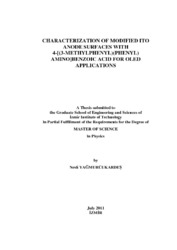Please use this identifier to cite or link to this item:
https://hdl.handle.net/11147/3141Full metadata record
| DC Field | Value | Language |
|---|---|---|
| dc.contributor.advisor | Okur, Salih | - |
| dc.contributor.author | Yağmurcukardeş, Nesli | - |
| dc.date.accessioned | 2014-07-22T13:50:57Z | - |
| dc.date.available | 2014-07-22T13:50:57Z | - |
| dc.date.issued | 2011 | - |
| dc.identifier.uri | http://hdl.handle.net/11147/3141 | - |
| dc.description | Thesis (Master)--Izmir Institute of Technology, Physics, Izmir, 2011 | en_US |
| dc.description | Includes bibliographical references (leaves: 90-101) | en_US |
| dc.description | Text in English; Abstract: Turkish and English | en_US |
| dc.description | xiv, 101 leaves | en_US |
| dc.description.abstract | This thesis focuses on to improve OLED characteristics of fabricated devices by modifying the ITO (anode) surface using novel carboxylic acid based molecule 4-[(3-methylphenyl)(phenyl)amino]benzoic acid (MPPBA). In this study, commercial ITO substrates were used as anodes. To modify the ITO surface, etched ITO substrates were kept in 1mM MPPBA-ethanol solution. As a hole transport layer (HTL), N,N'-bis(3-methylphenyl)-N,N'-diphenylbenzidine (TPD) or N,N'-Di-[(1-naphthyl)-N,N'-diphenyl]-1,1'-biphenyl)-4,4'-diamine (NPB) small molecules were deposited using an organic evaporator system under the vacuum of 10-6 Torr. Finally, as a cathode contact layer, aluminum thin film of 120 nm was deposited on top of the fabricated organic thin film layers. The final structure of the devices was obtained as ITO /SAM (2nm) /HTL (50nm) /Al (120nm). The current-voltage characteristics of devices of unmodified bare ITO and MPPBA modified ITO substrates were analyzed by using the space charge limited current approach and Thermionic Schottky Emission Models. Additionally, surface characterizations of the SAM modified thin films were carried out using Quartz Crystal Microbalance (QCM), Atomic Force Microscopy (AFM), Kelvin Probe Force Microscopy (KPFM), X-ray Photoelectron Spectroscopy (XPS), Cyclic Voltammetry (CV) and Ultraviolet-visible Absorption Spectroscopy (UV-Vis) techniques. The obtained results reveal that the modification of the ITO surface with MPPBA molecules reduces the barrier height difference between the Fermi level of the anode and HOMO level of the HTL. Hence the hole injection increases while the turn-on voltage decreases. As a result of this process OLED characteristics were improved by using the MPPBA SAM molecules. | en_US |
| dc.language.iso | en | en_US |
| dc.publisher | Izmir Institute of Technology | en_US |
| dc.rights | info:eu-repo/semantics/openAccess | en_US |
| dc.subject.lcsh | Light emitting diodes | en |
| dc.subject.lcsh | Organic electronics | en |
| dc.subject.lcsh | Thin films | en |
| dc.subject.lcsh | Metal oxide semiconductors | en |
| dc.title | Characterization of Modified Ito Anode Surfaces With 4 [3-Methylphenyl) Phenyl) Anino] Benzoic Acid for Oled Applications | en_US |
| dc.type | Master Thesis | en_US |
| dc.institutionauthor | Yağmurcukardeş, Nesli | - |
| dc.department | Thesis (Master)--İzmir Institute of Technology, Physics | en_US |
| dc.relation.publicationcategory | Tez | en_US |
| dc.identifier.wosquality | N/A | - |
| dc.identifier.scopusquality | N/A | - |
| item.languageiso639-1 | en | - |
| item.grantfulltext | open | - |
| item.fulltext | With Fulltext | - |
| item.openairecristype | http://purl.org/coar/resource_type/c_18cf | - |
| item.openairetype | Master Thesis | - |
| item.cerifentitytype | Publications | - |
| Appears in Collections: | Master Degree / Yüksek Lisans Tezleri | |
Files in This Item:
| File | Description | Size | Format | |
|---|---|---|---|---|
| T000949.pdf | MasterThesis | 3.8 MB | Adobe PDF |  View/Open |
CORE Recommender
Page view(s)
346
checked on Jun 16, 2025
Download(s)
108
checked on Jun 16, 2025
Google ScholarTM
Check
Items in GCRIS Repository are protected by copyright, with all rights reserved, unless otherwise indicated.